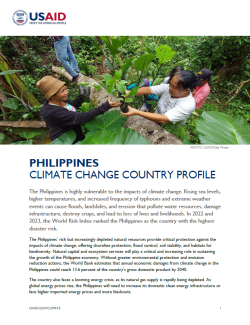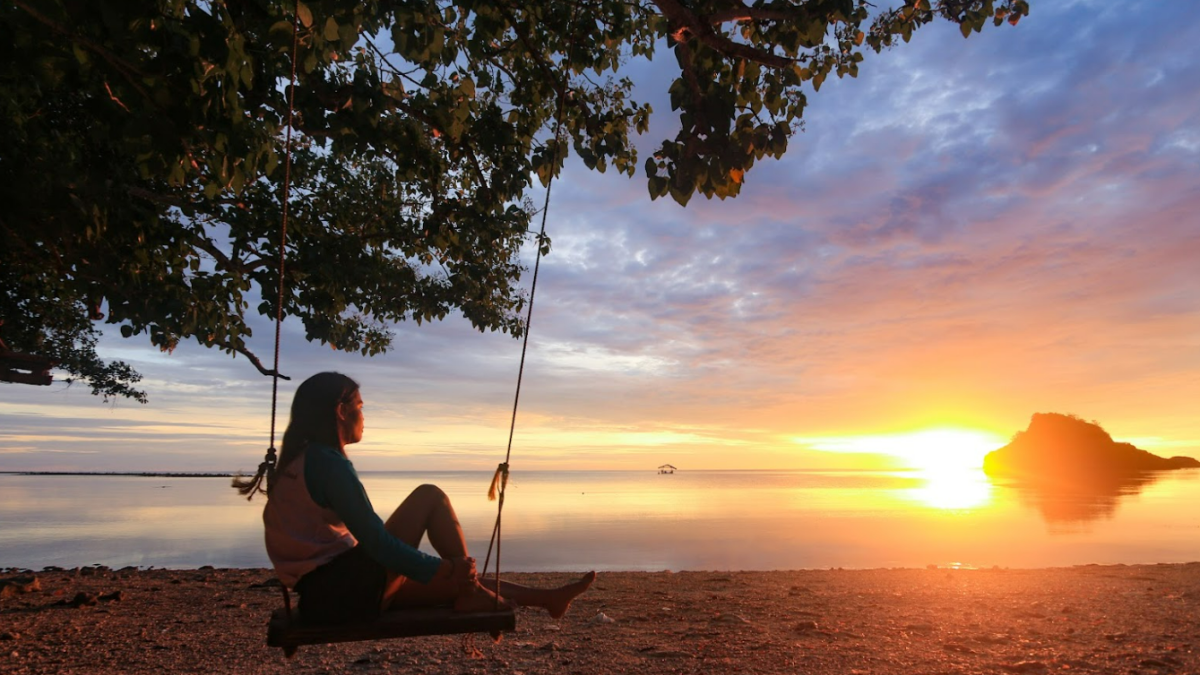The Philippines’ rich but increasingly depleted natural resources provide critical protection against the impacts of climate change, offering shoreline protection, flood control, soil stability, and habitats for biodiversity. Natural capital and ecosystem services will play a critical and increasing role in sustaining the growth of the Philippine economy. Without greater environmental protection and emission reduction actions, the World Bank estimates that annual economic damages from climate change in the Philippines could reach 13.6 percent of the country’s gross domestic product by 2040.
The country also faces a looming energy crisis, as its natural gas supply is rapidly being depleted. As global energy prices rise, the Philippines will need to increase its domestic clean energy infrastructure or face higher imported energy prices and more blackouts.
Government of the Philippines Climate Priorities
The Government of the Philippines’ Nationally Determined Contribution (NDC) supports the country’s national development objectives and priorities of sustainable industrial development, poverty eradication and inclusive growth, energy security, social and climate justice, and the transformation of its socio-economic sectors towards a climate- and disaster-resilient, low-carbon economy. The Government of the Philippines has committed to reducing greenhouse gas emissions by 75 percent by 2030, one of the most ambitious targets in Southeast Asia. To accelerate its transition to a green economy, the country also aims to increase the share of renewable energy to at least 35 percent of its power generation mix by 2030 and to 50 percent by 2040. The country is also committed to working toward these goals while ensuring the rights of Indigenous Peoples and protecting the country’s natural resources.
USAID’s Climate Change Program: Objectives and Results
USAID supports the Government of the Philippines’ development and climate priorities through a series of programs and partnerships supporting climate adaptation, renewable energy, and climate mitigation through sustainable landscapes.
Adaptation
USAID assistance in the Philippines improves natural resource management, promotes water and energy security, increases access to climate finance, and reduces vulnerability to climate-related disasters such as floods and typhoons. USAID helps local governments, communities, and other partners to better understand, use, and disseminate climate information to build the resilience of Filipino communities.
Key Results
USAID has helped:
- Secure funding for climate initiatives, helping local governments in the Philippines access $2.5 million in climate financing in 2023 to implement their respective local climate programs;
- Integrate climate resilience measures into six local government plans since 2021 to better protect 2.8 million people from climate impacts;
- Mobilize more than $72.5 million in water, sanitation, and hygiene investments since 2021, enabling more than one million people to gain access to improved drinking water and more than 271,000 people to gain access to basic sanitation services;
- Prevent more than 4,000 metric tons of solid waste—roughly 286 truckloads of waste—from entering the environment since 2019, reducing plastic pollution that otherwise clogs waterways and causes flooding;
- Protect 3.3 million hectares of oceans in the Philippines since 2018, ensuring a sustainable source of food and livelihoods for millions of Filipinos; and
- Evaluate how fish species and their habitats could be affected by ongoing and intensifying climate change, working with the Government of the Philippines to develop adaptation measures to reduce the severity of climate change impacts.
Renewable Energy
USAID supports the deployment of advanced energy sector technology and works to improve the performance and resilience of Philippine energy utilities. In partnership with the Government of the Philippines’ Department of Energy and Energy Regulatory Commission, USAID is working to improve the environment for private investment and competition in the energy sector.
Key Results
USAID has helped:
- Support the Government of the Philippines Department of Energy’s Green Energy Auctions Program since 2022, resulting in more than 5.3 gigawatts of renewable energy projects—nearly a fifth of the country’s power system—valued at more than $6.6 billion in investments. These renewable energy projects are projected to avoid more than 69.7 million metric tons in CO2 equivalent emissions over 15 years;
- Facilitate the Government of Philippines Department of Energy’s efforts to establish the first comprehensive Energy Resilience Scorecard system in the Association of Southeast Asian Nations (ASEAN). The scorecard’s national rollout lays the groundwork for improved services across all 152 distribution utilities and electric cooperatives in the country, serving more than 90 percent of the population.
Natural Climate Solutions
Forests and other natural resources hold enormous potential for climate mitigation, but deforestation threatens to undermine this potential in the Philippines. USAID supports natural climate solutions through reforestation, improved rice production technology, and improved management of livestock and livestock waste.
Key Results
USAID has helped:
- Craft targeted solutions to environmental challenges in collaboration with Indigenous Peoples' communities. For example, in Bukidnon and Misamis Oriental, USAID and Indigenous partners established a sustainable value chain for a 1,400-hectare giant bamboo plantation, with potential global export and dividends from the sale of carbon credits. In Zambales and Palawan, USAID trained 156 members of Indigenous communities to serve as forest guards in several areas with high carbon mitigation potential;
- Drive efforts in Davao Oriental, working alongside Indigenous Peoples’ organizations, to assess the drivers of deforestation and develop forest protection plans for 89 percent of the province’s total forest land area. USAID also supported the creation of a local consortium that spearheaded public awareness campaigns and dialogues to promote forest protection and biodiversity conservation;
- Support improved management for more than 3.7 million hectares of biologically significant areas since 2021, increasing the resilience of key forest and marine ecosystems. USAID also helped develop the Green Assessment and Green Recovery Planning Framework, which provides guidance in assessing and restoring biodiversity, ecosystems, and communities affected by typhoons and other disasters. After Super Typhoon Rai in 2021, for example, these tools helped identify about 90,000 hectares of degraded forests for restoration in Palawan and Siargao and supported communities in developing business plans to generate financing for forest restoration;
- Update and advance the national forest landscape and restoration plan, starting with the development of Palawan’s first-ever province-wide strategy for forest and landscape restoration in the aftermath of natural disasters. This plan aims to restore 71 percent of the forests damaged in northern Palawan over five years. USAID also supported restoration efforts, such as a green recovery plan that introduces agroforestry-based livelihood opportunities and helps rehabilitate mangrove forests, which benefit community-based sustainable tourism groups;
- Support the development of the Lawin Forest and Biodiversity Protection System, which is one of the Government of the Philippines Department of Environment and Natural Resource’s primary strategies for forest protection, even after USAID’s support for the system ended;
- Facilitate, in partnership with the U.S. Forest Service, efforts of the Government of the Philippines Department of Environment and Natural Resources to develop its Forest Reference Emission Level—a key requirement for reducing greenhouse gas emissions from deforestation and forest degradation—and submit it to the United Nations Framework Convention on Climate Change.




